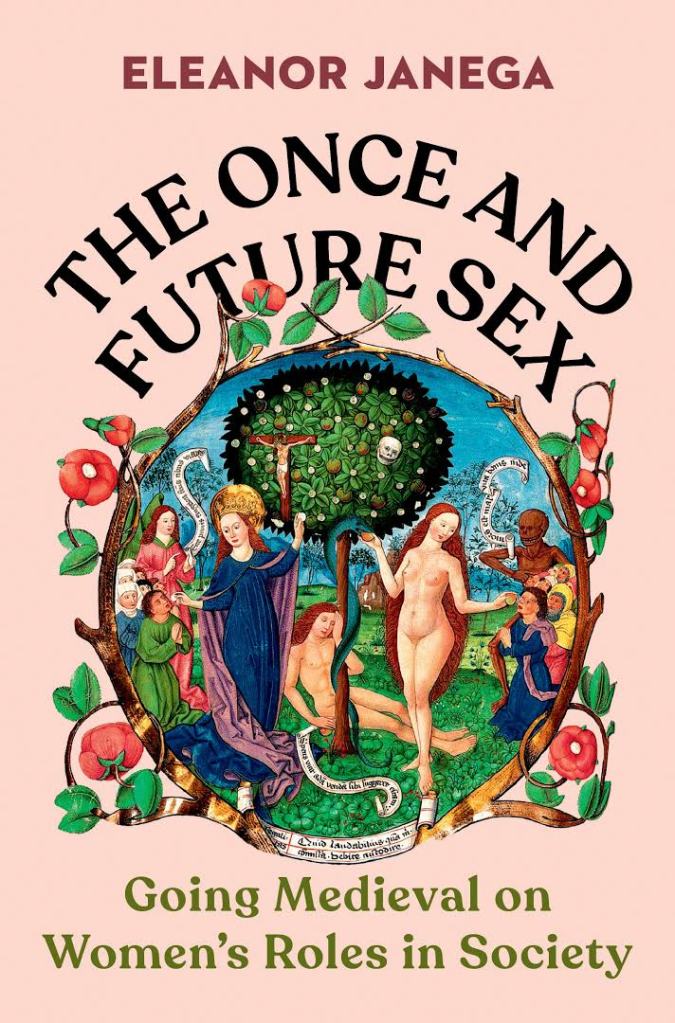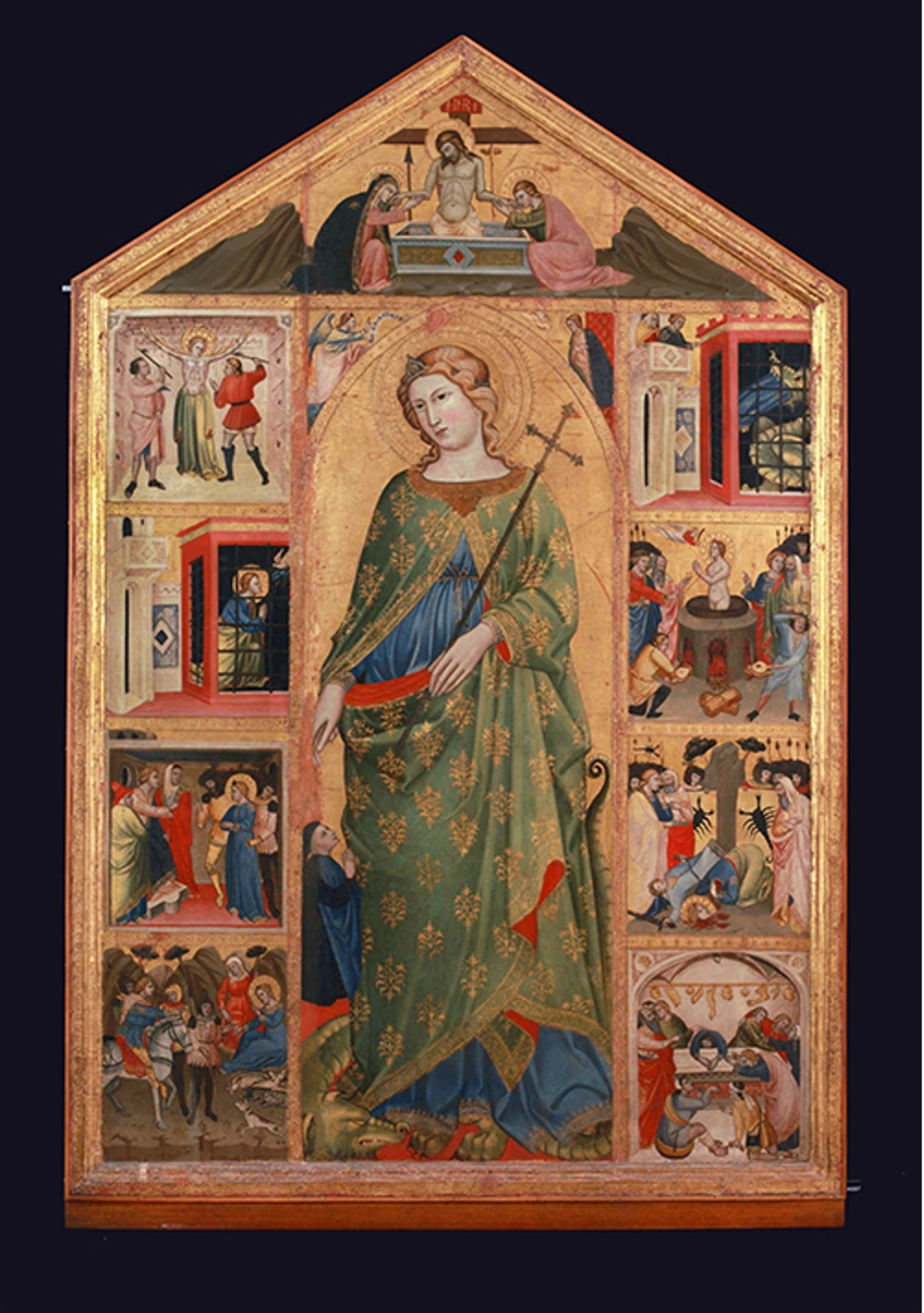Friends, since I made you all think about death recently I thought I would keep it light for you real quick and talk to you once again, about one of my favourite saints – the good St Margaret of Antioch. I was thinking about her recently because I was writing up something about your good friend and mine, Joan of Arc. See, Margaret was such a cool saint that even noted badass Joan looked up to her, and claimed that Margaret was one of the voices that spoke to her and told her to go out there and beat up some English people. My love for several English people, and currently location in the capital of England notwithstanding, I do agree that probably it’s good to beat them up when they are in your backyard stealing your pig. So, I think it is probably good that she was out there inspiring anti-invader violence. ANYWAY! If she’s good enough for Joan, she’s good enough for you, so today we’re going to learn all about her and how you can spot her in medieval art.
Now the thing about Margaret of Antioch is she probably didn’t exist, like as a corporeal person. This will become abundantly clear as we peruse her biography. Now haters will say that because she is fake, that we should discard her. You know what I say? Shut up. You’re fake. Just because she didn’t walk around on the earth doesn’t mean she’s not important. What is important is that cool people had a spiritual relationship with her. That relationship is real, even if she wasn’t a person somewhere. Hell, we make up myths about people who did exist all the time and imbue them with meaning. People will like, say that George Washington cut down a cherry tree and then wouldn’t lie about it and then act like that is what is important, rather than the fact that he was a genocidal slaver or whatever. And it is important! Cuz we talk about it. My point is I don’t care that she didn’t exist and if you do you are a nerd.
Anyway, her legend, which is good and cool, goes a little something like this. She was born in Antioch in what is now Turkey somewhere around 304. Her father was a pagan priest named Aedesius, and her mother died shortly after her birth. Margaret was promptly sent out to be nursed by a wetnurse a few miles outside of Antioch, and away from the watchful eye of her father. Thing about old dad here is he was too busy augering or something to check out the “personal interests” section on the wet nurse’s CV and wouldn’t you know it? The wetnurse was a Christian. Margaret, then was able to receive the succor not just of milk but of the Christian faith. As a part of this, and as was the style a the time she then also promised her virginity to God. Her dad was not particularly happy about this and decided that since she was just a low value woman and all, she could just be adopted by the nurse. He washed his hands of her and went back to paganing most paganly.

Now you know that because Margaret was very holy indeed, she was also incredibly hot. (Read all about it in my book The Once and Future Sex, why don’t you? Out now in paperback!) She was also now poor and had to do poor girl stuff like watch the flocks. There she was spied by a gross Roman prefect called Olybrius. Because she was hot he wanted to marry her, but that sort of clashed with her whole poor virgin Christian vibe and she told him to get lost. He did not take this well.
Now it’s bad enough to have a prefect who is mad at you, but it’s even worse to have one mad at you because you are very Christian and won’t shag them during the Diocletianic persecution. Because, well, it was illegal to be Christian at that point, and Romans were gross and did like to torture people for fun. Margaret was put on trial for hurting a man’s feelings and told that she needed to renounce her Christian faith, or face torture. Margaret, it turns out, was very stoked indeed to die for God which, again, was very much in style among Christians at the time. She refused and that’s when the torturing began.

Not every torture list agrees on what Margaret put up with. But most agree that first she was thrown in a fire, but the flames refused to burn her. So then she had her hands and feet tied and was thrown in boiling water. But her ropes loosened and she stood up out of the cauldron like it was no big deal. According to the monk Rabanus Marus Magnentius (c. 780-856) writing in the ninth century, said Olybrius “ordered her to be hanged on the rack with the most bitter claws to tear her flesh; afterwards he sent her into a dark prison, where she overcame the seductions of the devil, who appeared to her in the form of a dragon and an Ethiopian [sounds racist, but OK], and nothing of his deceit could harm her.”[1]
Luckily for us all the Ethiopian devil (?????) is often left off of this little caper so we can focus on the real star of the show the motherfucking dragon. See where Rabanus says he “seduced” Margaret most other people go with swallowed her whole. And Margaret? She wasn’t having any of that, so she simply made the sign of the cross which had her bust the fuck out of the dragon like a scantily clad hottie from a giant comedy birthday cake.
If you are enjoying this post, why not support the blog by subscribing to the Patreon, from as little as £ 1 per month? It keeps the blog going, and you also get extra content. If not, that is chill too.
This has been widely, and rightly considered to be one of the coolest moves of all time and is usually what Margaret is commemorated for, and how you know you are looking at Margaret in art. She’s the baddie busting out of the dragon comme ça:

As cool as that was Olybrius basically had it up to the eyeballs with Margaret at this point and had her decapitated, which is like, probably smart if you just wanted her dead. Anyway, he got what he wanted (revenge on a woman for making him sad). She got what she wanted (the holy crown of martyrdom and to never see that dude again). Everyone’s happy!
Because Margaret did cool stuff like bust out of dragons she was very very popular in medieval Europe. In the medieval German lands, by the fourteenth century, she was named as one of the fourteen holy helpers who were thought to be particularly down to intercede with you in times of sickness.

More specifically, St Margaret was included in this bunch not just because she was a super cool saint that everyone loved because – very specifically – by this time she was considered the patron saint of childbirth.
I am sorry but I love this so much? Get it? She busted TF out a dragon safely like you want a baby to come out of the womb. I mean, however one does hope that the mother isn’t the dragon in this instance, but like, come on. It’s so cool.
She was also invoked for escape from tormenters and also backache, which is equally funny, to me.
Sometimes, in the German tradition Margaret is associated not with a dragon, but instead with a lindworm. This is cool because lindworms are a specific central and north European monster that is like a giant snake that has wings, two to four legs, and lives deep in forests. Fun fact about the legs thing, they don’t walk on them like a dragon or a wyvern though. Instead they sort of slither along and use the legs to drag themselves. It’s neat. Now, I would say that since we are pretending my girl was from Antioch, and not Europe than we don’t get to name the monster as a lindworm, but I am also hyper aware of the fact that this distinction makes no sense at all whatsoever. I mean it’s a monster, so like do with it what you want. I, however, like to stick with my dragon distinction here.

Now that you know how to spot Margaret you are going to see her around a lot. People loved her because, well, childbirth was scary and painful, and women wanted to feel like they had a bad ass dragon slayer on their side while they went through it. She also shows up because it’s cool to make art of dragons. Or lindworms. Or whichever monster really. It was such a popular subject that I had a really hard time finding any images of her that didn’t include the dragon that wouldn’t spoil the surprise for you all. So, a nice rule of thumb for medieval art: If blonde girl and a dragon you see, Margaret that be. IDK man I am just jamming. Make your own rhymes. I’m the one doing all the work around here.
The lesson here is that only nerds think it matters that saints existed, childbirth is scary, dragons are cool, and it’s fun to look at medieval art. I think that’s enough. It doesn’t always have to be that deep, you know?
[1] “…multis tormentis eam afflixit , hoc est, in equuleo suspensam ungulis acerbissimis jussit carnes ejus lacerare: postea in carcerem tenebrosum eam misit ubi diaboli seductiones, qui in specie draconis et Aethiopis illi aperuit, superavit, et nihil ei illius fraus nocere potuit”. J.P. Migne (ed.), Acta Sanctorum, Julii, Tomus Quintus, (Paris: Jacob du Moulin, 1727), 24. <Accessed 29 January 2024>
For more on my fav saints see:
St Wenceslas
St Procopius of Sázava
St Sebastian
St Nicholas
Support the blog by subscribing to the Patreon, from as little as £ 1 per month! It’s the cool thing to do!
My book, The Once And Future Sex: Going Medieval on Women’s Roles in Society, is out now.

© Eleanor Janega, 2024


Came for the cool article on St Margaret of Antioch, stayed for the awesome website about paintings / frescoes in English churches. What a goldmine.
LikeLike